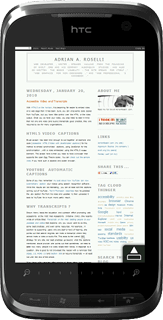Targeting the Mobile Web
 Given the rise of mobile computing on phones and pads, web developers can no longer think of the sites they develop as living in the world of the desktop browser. Thankfully, things are much easier than they used to be. Developers no longer need to focus on arcane reformulations of specs wrapped in TLAs like WML, but are now free to utilize current technologies with a lot less agony — if they do it right. To that end, the following presenters outline some best practices for web developers as they bring their talent to the mobile web.
Given the rise of mobile computing on phones and pads, web developers can no longer think of the sites they develop as living in the world of the desktop browser. Thankfully, things are much easier than they used to be. Developers no longer need to focus on arcane reformulations of specs wrapped in TLAs like WML, but are now free to utilize current technologies with a lot less agony — if they do it right. To that end, the following presenters outline some best practices for web developers as they bring their talent to the mobile web.
Andreas Bovens
Andreas Bovens led a mobile web development workshop in July at the Mobile 2.0 Conference in Barcelona. Since I couldn’t attend, and something tells me neither could you, he has provided his presentation as an 18 minute screencast. In it, he outlines three approaches to mobile web development:
- Do nothing: For the most part, this works fine in modern mobile browsers. Liquid layouts tend to work best.
- Create a separate mobile site: Rely on user agent detection to shunt users to one or the other site while still offering a link to override.
- Create one site that works for all: Let one site adjust its layout for different devices.
The use of the viewport meta tag is covered along with media queries. Watch the video to see all the details.
Bruce Lawson
Bruce Lawson presented on the broader topic of web development in the new world of HTML5, CSS3, mobile, and all the things that come along with those new standards and technologies. He has posted his Over the Air 2010 talk along with a great list of reference links.
Sadly, the Slideshare doesn’t work on that page, but you can view it below. Jump to slide 42 for the information on the mobile web.
Bryan Rieger
In this presentation we see a simple argument espoused by Luke Wroblewski, among many others, which is to design for mobile first (Luke Wroblewski on Mobile First). Start with the mobile platform, and then add in support for desktop browsers, building the site up instead of tearing things off. A simple concept that not everyone seems to understand.
You can see some of the same points in this set of slides, with a focus on the trends instead technical implementation discussions. This one is handy for explaining the rise of mobile to non-developers.
Tim Berners-Lee
Widely credited with inventing the world wide web, having Tim Berners-Lee weigh in on developments in mobile computing certainly adds an interesting perspective on these trends. At Nokia World 2010, Tim Berners-Lee detailed four concerns about the future of the mobile web:
- Privacy: Specifically discussing location-aware devices, he thinks we might all have to adjust how we think about privacy as a core concept.
- Accountability: As companies learn about us more and more, including our location, we need to have methods in place to ensure they aren’t abusing our data.
- Neutrality: Net neutrality is a topic he discusses a lot, and this is a great opportunity for him to argue that net neutrality should exist for all web platforms.
- Access: With so much of the world unable to afford computers or mobile data plans, sites need to be diligent about smaller pages and low cost data plans need to be developed.
How his concerns will bear out, along with the technical implementation techniques outlined above, will be quite interesting to watch in the near and far future. If you are a web developer, you should be asking if you’ll be helping or hindering.
Leave a Comment or Response